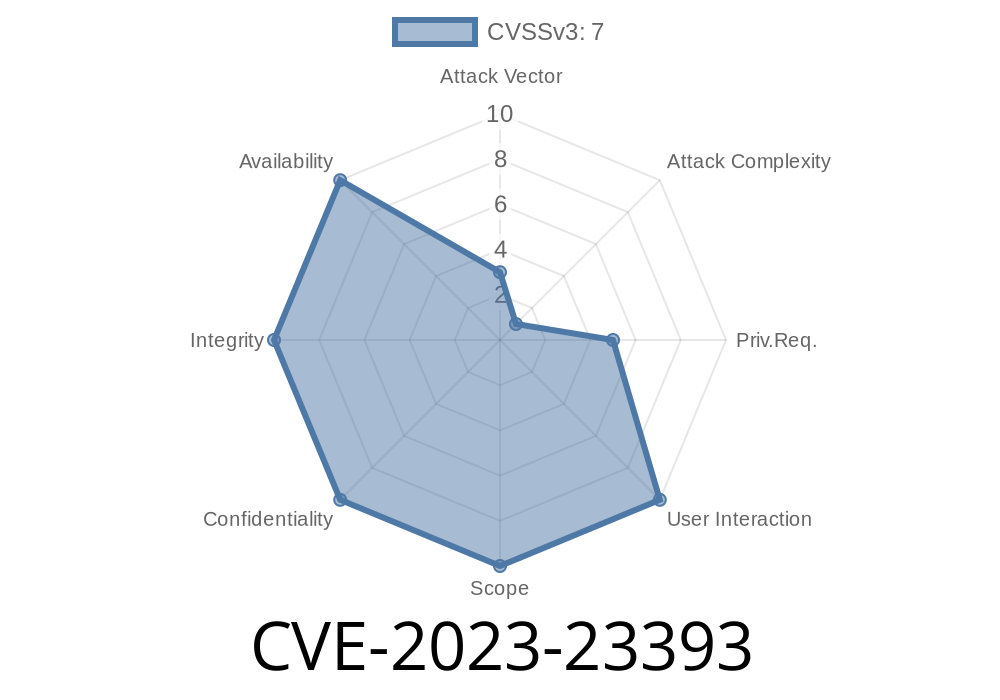In early 2023, Microsoft disclosed a significant vulnerability tracked as CVE-2023-23393. This bug affects the Windows BrokerInfrastructure Service and, if exploited, could let attackers elevate privileges on a Windows system—potentially taking over machines even with basic user access. In this post, we’ll break down what this vulnerability is, how it works, show sample proof-of-concept code, share links to original resources, and discuss exploit techniques—keeping it simple and clear for everyone.
What Is CVE-2023-23393?
CVE-2023-23393 is an *elevation of privilege* issue in the BrokerInfrastructure Service. The BrokerInfrastructure Service is responsible for managing and brokering communication between apps and services on the Windows platform. If not properly secured, these kinds of services can offer attackers a way to execute code with higher privileges.
According to Microsoft's official advisory:
> An elevation of privilege vulnerability exists when BrokerInfrastructure Service improperly handles file operations. An attacker who successfully exploited the vulnerability could run arbitrary code with SYSTEM privileges.
Server 2016, 2019, 2022: All supported editions
Systems that haven’t installed updates from March 2023 or later may be exposed.
How Does the Vulnerability Work?
The problem comes down to *improper file permissions*. BrokerInfrastructure runs as the SYSTEM user. If it interacts with files or directories that can be modified by regular users, an attacker could plant malicious files or manipulate them in ways that trick the service into loading or executing attacker-controlled code with SYSTEM rights.
This scenario is called a “privilege escalation”—moving from a low-privilege user account to the highest level of control (SYSTEM).
The Service: BrokerInfrastructure.exe runs as SYSTEM.
- Vulnerable Action: Handles certain files that can be influenced or replaced by lower-privileged users.
- Exploit Path: Attacker creates or replaces a file in a monitored directory, waits for the service to act, and achieves code execution as SYSTEM.
Example Exploit Flow
To make it clear, here’s an example of how an attacker could exploit this bug on an unpatched machine:
1. Find a directory or file accessed by BrokerInfrastructureService that the attacker can tamper with (often, temp locations like %ProgramData% or %TEMP%).
Trigger the service to access the file (sometimes by just rebooting or using a service trigger).
4. Gain SYSTEM: When the service loads or executes the attacker’s file, the code runs with the highest privileges.
Proof of Concept (Pseudo-Code)
> ⚠️ For Educational Purposes Only! Do not run this code on real systems.
Here's a simplified proof-of-concept in Python, simulating a file replacement attack
import os
import shutil
# Assume C:\ProgramData\BrokerTemp is monitored by BrokerInfrastructure
target_dir = r'C:\ProgramData\BrokerTemp'
malicious_payload = r'C:\Users\user\malicious.dll'
target_file = os.path.join(target_dir, 'broker_task.dll')
# Make sure attacker has write permissions; replace DLL
try:
shutil.copy2(malicious_payload, target_file)
print(f"Malicious DLL copied to {target_file}")
except Exception as e:
print(f"Failed to copy malicious DLL: {e}")
# Now, wait for the BrokerInfrastructure Service to load the DLL...
If this directory and file were actually used by BrokerInfrastructureService, your custom DLL could be loaded with SYSTEM rights.
Many real exploits rely on DLL hijacking and symlink attacks.
- Tools like Process Monitor help researchers find what files services open.
- If file or directory permissions are too broad (Everyone:Full Control), standard users can swap out files.
- Using NTFS reparse points is common in advanced attacks.
Microsoft’s official vulnerability page:
https://msrc.microsoft.com/update-guide/vulnerability/CVE-2023-23393
Rapid7 Analysis:
CVE-2023-23393 - BrokerInfrastructure EoP
Windows BrokerInfrastructure Service documentation:
https://learn.microsoft.com/en-us/windows/win32/services/services
Install all Windows updates from March 2023 or later.
- Check for directories/services that regular users can write to.
- Use tools like AccessChk to analyze permissions.
Summary
CVE-2023-23393 is a classic example of how a service running as SYSTEM, plus bad file permissions, equals a big security problem. Always patch your systems, audit file permissions, and remember that attackers love services like BrokerInfrastructure because they bridge the gap between normal users and full SYSTEM access.
> Feel free to share or ask questions for deeper technical details. Stay safe! 🛡️
Timeline
Published on: 03/14/2023 17:15:00 UTC
Last modified on: 03/23/2023 16:59:00 UTC
